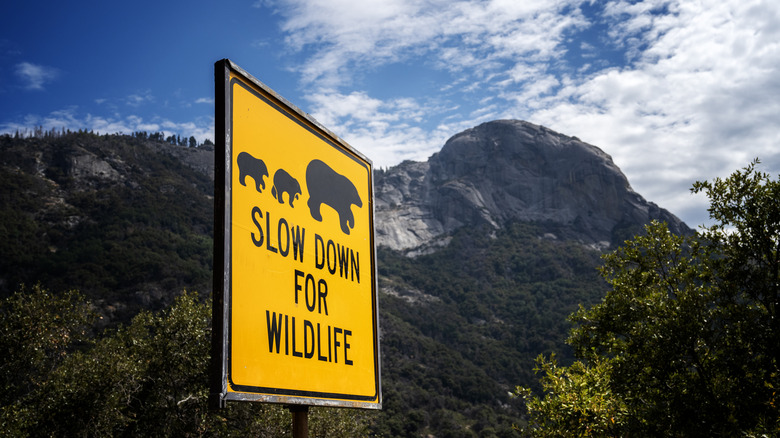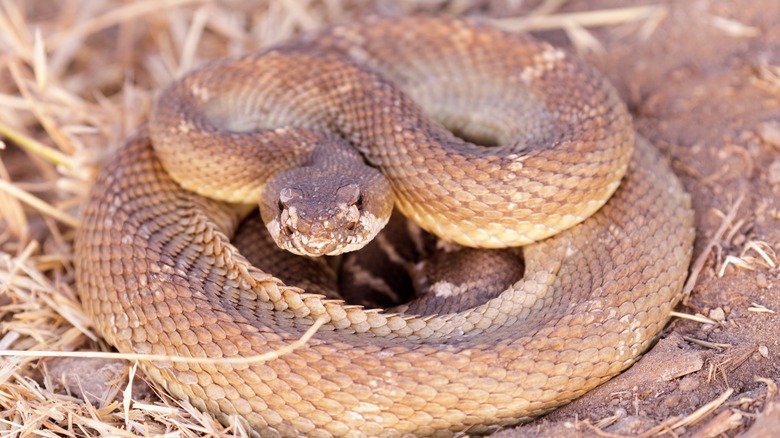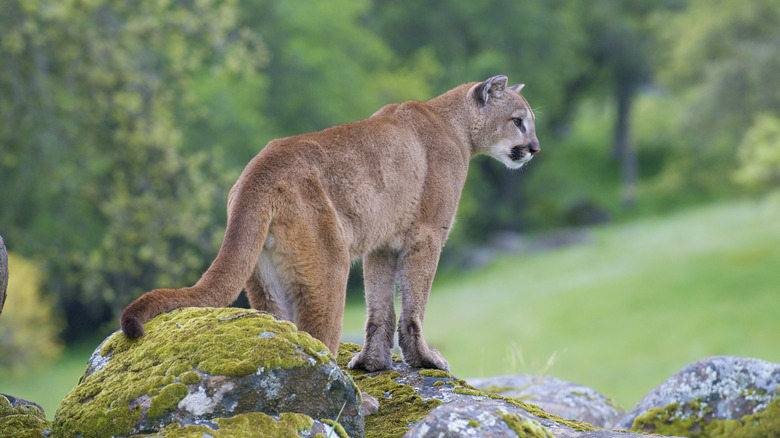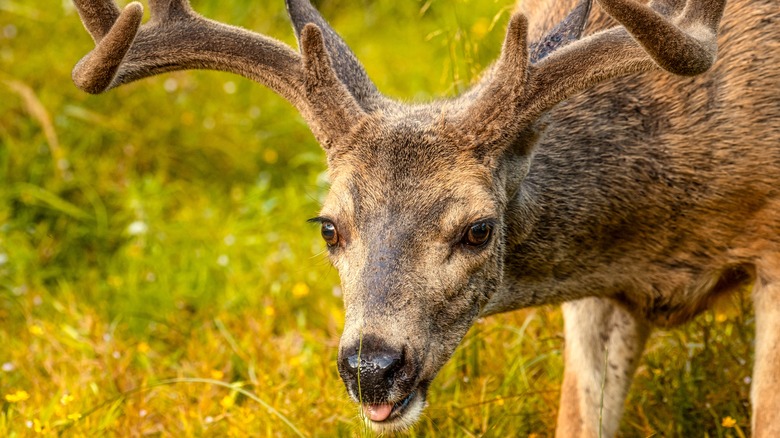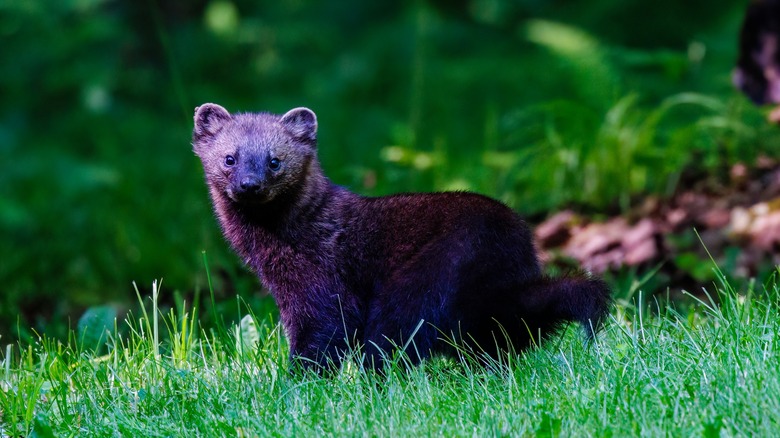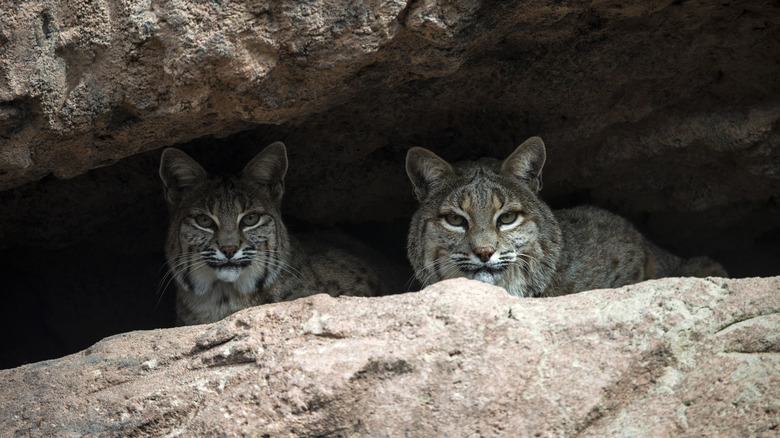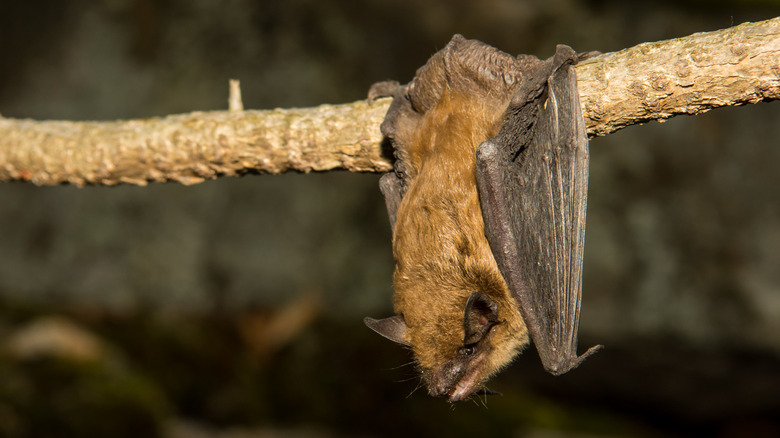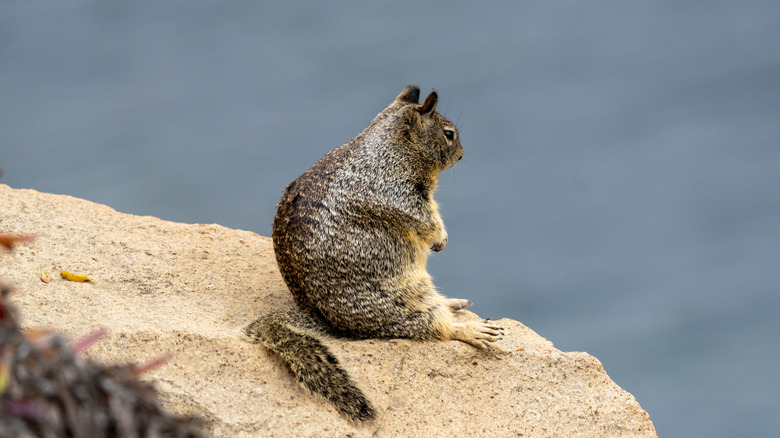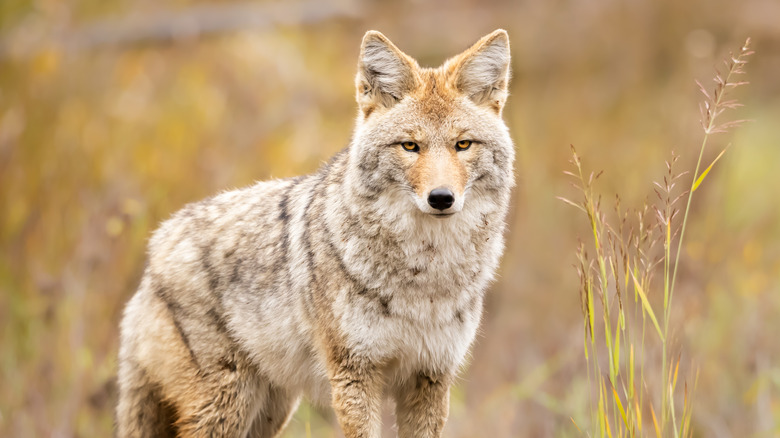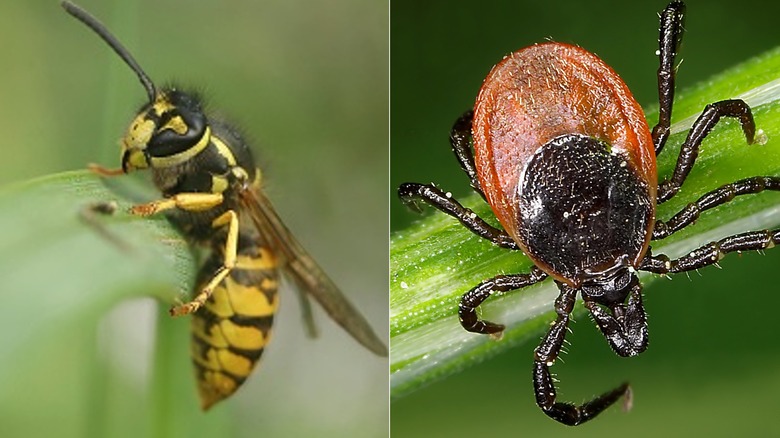Creatures To Beware Of When Adventuring In Yosemite National Park
As one of the oldest National Parks in the United States, Yosemite maintains a special aura that draws an average of 3.5 million visitors to the park each year. Whether they are there to gaze at the majesty of Yosemite Falls or hike the breathtaking Half Dome, the park has something to offer every type of outdoor lover. However, for all of its natural beauty, Yosemite is not without its dangers. And if there is one thing that is particularly dangerous about Yosemite, it's the wildlife one could encounter there.
Nestled in east-central California, Yosemite is home to a variety of different animals. Ganyah Gold is a Wildlife Biologist and expert on the types of creatures park visitors should be aware of. "In Yosemite National Park, be particularly cautious of black bears, mountain lions, rattlesnakes, and ticks," she cautions.
Gold is going to serve as our guide throughout this list as we take the time to dive into the types of creatures you need to be aware of when adventuring at Yosemite National Park. "With the right knowledge and precautions, you can avoid interactions and fully enjoy Yosemite's beautiful natural scenery," she said.
Keep your ears open for the northern pacific rattlesnake
As Gold mentioned, rattlesnakes are one of the first creatures you need to be on your guard for when hiking in Yosemite. The specific breed that slithers through the woods of the park is the northern pacific rattlesnake. This snake is not particularly large, but it has perfect shades of brown scales that help it blend seamlessly into Yosemite's environment. While its primary targets are squirrels and other rodents, the northern pacific rattlesnake can attack humans if they are startled or feel threatened.
Fortunately, there are ways to avoid a snake attack. As Gold explains, "Stay calm and freeze when you see a snake. Research which snakes in Yosemite are venomous to help in these situations. Back away slowly." Note that an attack from a northern pacific rattlesnake could be particularly dangerous, as they are a highly venomous species. However, Gold's tips are usually be enough to scare one away.
However, if you are bitten, you need to seek immediate medical attention. According to Gold, "If bitten, note the color, patterns, and head shape of the snake to identify if it is venomous. Wash the wound, avoid movement, and stay relaxed to prevent the venom from spreading." You can identify the northern pacific rattlesnake by its triangular head and distinctive rattle.
Black bears are shy but will attack if threatened
Black bears are not the most dangerous type of bear you could encounter in North America, but they are certainly the type that you are most likely to encounter in Yosemite. According to Gold, "Yosemite has about 500 black bears." So, how does one avoid contact with these animals? "Surprisingly, bear spray is not allowed," notes Gold, adding, "Instead, use bear lockers provided at campgrounds to store food and anything with strong smells. Never leave these items in your car, tent, or roof compartment overnight to prevent attracting bears."
Keeping your food stored properly is definitely going to help keep the bear away from your campsite, but what about if you run into one while hiking? Black bears tend to be very shy, and would rather climb a tree and hide as opposed to dealing with people. If they feel threatened by you, however, that's another story.
The National Park Service recommends staying at least 50 yards away from any bear you see. Any closer could feel like an encroachment. You can raise your arms and make loud noises to ward them off. Hikers with dogs are at higher risk as a barking dog tends to make the bear feel threatened and more likely to protect itself. Making sure your dog is leashed is important, too. If your dog gets loose and goes after a bear, that's bad news for you both.
Mountain lions will see you before you see them
The chances of being attacked or killed by a mountain lion are extremely low, but there is always a rare exception. "There are only about 35 known mountain lions in Yosemite, and they are more threatened by humans than the other way around," Gold tells us. These big cats will tend to avoid people as much as possible, so much so that you could be hiking near one of them and never even know that they were watching you.
If you do come across a mountain lion, Gold has some safety measures you can take. "If you encounter a mountain lion, do not run. Maintain eye contact, make yourself look big and intimidating by raising your arms and speaking in a loud, deep voice. If necessary, throw sticks or rocks. If attacked, fight back as a last resort."
One of the things you can do to mitigate the potential for an encounter ahead of time is to make plenty of noise while hiking. "While walking, make some noise to alert animals to your presence ... they will usually avoid you if they hear you coming." This is effective as, remember, the majority of the time, these animals are more frightened of us than we them.
Don't offer treats to a mule deer
The mule deer that roam Yosemite National Park may seem harmless enough, but don't be fooled by this demeanor. The National Park Service has stated that more people have been attacked by mule deer at Yosemite than any other animal in the park. This is cause for concern, seeing as deer are usually quite docile creatures and tend to avoid people as much as possible. So, what gives?
According to Gold, "Mule deer may seem gentle, but during mating season, males can be aggressive, and females with calves are very protective. It's best to keep your distance during these times. For all wildlife, it's best to keep a distance while enjoying their presence." Keeping your distance means holding back that human impulse to feed animals that are too cute to seem dangerous. This is a massive miscalculation. Not only does the feeding of wild animals have the potential to make them dependent upon it, it can also be extremely dangerous. These attacks on tourists, whether by a male in mating season, or a female being protective of their young, are all the result of people getting far too close for the deer's comfort.
Fishers are elusive but fierce when cornered
Like most of the creatures on this list, the danger posed by a pacific fisher is not so much in its aggressive behavior towards people, but what it is capable of when it is cornered. Part of the larger fisher family, the pacific fishers of Yosemite are rare and elusive. The Park Service has gone through considerable effort to track down these creatures in order to learn more about them and make sure that knowledge is passed along to visitors.
Just like bears, fishers are drawn to your food and can become bold when it comes to snatching it away. Their large, sharp claws and teeth will be used to scratch and bite anything that they can reach. You could end up bloodied if you're not careful and don't take Gold's prior advice about keeping your distance.
A pacific fisher is not likely to kill you, but you aren't doing yourself, or it, any favors by going after one. Even though you're not likely to come across one of these animals, you can be alerted to their presence if you pay enough attention. As Gold says: "Be aware of your surroundings and look out for signs of wildlife, such as tracks, droppings, or claw marks." She also adds, "Avoid hiking or trail running with headphones so you can hear any unusual sounds."
Don't get in a head-butting contest with a bighorn sheep
While most of us have only ever had encounters with domesticated sheep, there are still breeds of wild sheep out in the world that should give us pause. Like the bighorn sheep of Yosemite, for instance. Only reintroduced to the park a few years ago, the bighorn sheep nevertheless represent something of a hazard for visitors. Though these animals live in the more rocky and mountainous areas of the park, hikers and campers might still encounter some when they are visiting Yosemite.
Like with the mule deer, it is the rams that you need to watch out for the most when adventuring in the park. During mating season, these guys will battle one another over a ewe. The rams challenge each other by running full speed and smashing their heads together with brutal force. Depending on how hard the hit is, it could easily leave one of the sheep unconscious. So, imagine what getting hit by one would do to you?
Another thing to be aware of, like with the black bears, is the presence of food. If you're camping in the realm of these sheep, please pack up your food.
Don't be fooled by a bobcat's cuteness
Despite their resemblance to Gerald, your friendly neighborhood house cat, bobcats are wild animals that are not to be trifled with. While they, like their larger mountain lion cousins, are very shy and elusive, that does not mean that they do not pose a problem when properly threatened. Thanks to their large paws and sizable teeth, these larger cats have powerful predatory instincts that can make them quite a force to be reckoned with.
Being a predatory species, bobcats will defend their territory if they feel it is being encroached upon. They do not tend to do this with people. In fact, bobcats tend to avoid contact with humans whenever possible. However, should the incredibly rare event occur where you happen to come across a bobcat in Yosemite and have aggravated it enough to strike, you could be in for some pain.
If a bobcat felt so inclined, it could leave a hiker pretty severely wounded. Though they only tend to weigh between 13 to 30 pounds, all of that weight is muscle. As with any other wild animal, it is best to never approach one and let it go along its merry way.
A brown bat can leave a good bite
Owing to its location in the Sierra Nevada Mountain range, Yosemite National Park is home to its fair share of caves and caverns. As such, it makes for a fantastic environment for bats to dwell. There are several species of bats that call Yosemite home. The largest and most prolific species of them all is the big brown bat. Alliteration aside, the brown bat's commonality does not mean that it comes into contact with people all that often. Still, there is cause to be wary.
Like most bats, brown bats prefer to hunt for larger insects to eat as opposed to going after people. This does not mean, however, that the brown bat does not have a means of defending itself if it becomes cornered or feels threatened. Brown bats have razor sharp teeth that can easily pierce human skin. While the resulting gash is certainly painful, what else the bat could leave behind is far worse.
Bats are known harbingers of zoological diseases like rabies, and are actually among the most common of all animals to spread this deadly disease. If a rabid bat bites you, the rabies could very easily get into the bloodstream and begin to attack your nervous system. If bitten, an immediate course of medical treatments should be taken.
Ground squirrels can leave you without food
While they aren't going to cause bodily harm, California ground squirrels can nevertheless pose something of a problem. Like many other wild rodents, ground squirrels are opportunists. If they see a chance to cause some kind of mischief, they will do so. And this mischief almost always centers around the availability of food.
The sad reality is that all too many campers and hikers are careless about where they leave out their food. Not only will this draw the likes of bears, coyotes, and bighorn sheep to your campsite, but it will also bring out the wild rodents. You need to make sure that your food is properly secured inside of airtight containers that do not emit any scent. You can't just leave things inside of your tent and think that they are safe.
With the ground squirrel, if they want something badly enough, they will fight their way to get to it. They will chew through the fabric of your tent and get to your food. Then you are not only left with a gaping hole in your tent, but your food is now either missing or contaminated thanks to the presence of the wild animal. So again, it may not attack you physically, but a raid by a ground squirrel is certainly inconvenient.
Mountain coyotes are larger than you might think
Coyotes are a common sight throughout California. Yet, while most people will find smaller coyotes rifling through their garbage or attacking their house pets, the coyotes that roam the wilds of Yosemite are eye-opening to all who visit. Known as mountain coyotes, these wild dogs are so large that they have been mistaken for wolves in the past. They are certainly large enough to be intimidating, and should definitely not be approached under any circumstances.
The good(ish) news is that these carnivorous scavengers don't tend to attack people. They are far less inclined to approach humans if they can help it. This is not to say, however, that encounters do not occur. It's just that they are incredibly rare.
However, if you should come across one, you would do well to remember Gold's advice of making yourself look intimidating or throwing sticks to scare it away. While this is the advice she gave for mountain lion encounters, it will work with the likes of coyotes and black bears just as well. The majority of the time, these animals will retreat without a second thought.
Be cautious of yellow jackets and ticks
Finally, we have two of the most common pestilential insects that you can come across when in Yosemite: yellow jackets and ticks. Starting with the stinging bugs, yellow jackets are among the most common types of aggressive bees there are. Commonly found around camp picnics, yellow jackets are drawn to sugars and fats present in most human foods. This is aggravating, seeing as they are among the most prolific stingers of their kind. People would do well to avoid these creatures, especially if they are allergic.
Ticks, on the other hand, are far more difficult to get rid of. While there are many things you can do to avoid ticks, if one of them wants to bite you, it will do so. The best thing you can do is to follow Gold's advice: "After hikes, check your body for ticks. If you find one, use tweezers to firmly grasp the head and pull it out. This is important as ticks may carry Lyme disease."
Overall, if you make sure to take the proper precautions and are aware of your surroundings, there is no reason why you will come into harmful contact with any of these animals. Take it from Gold, who says, "By being prepared and knowledgeable, you can minimize risks and enjoy your adventure in Yosemite National Park safely."
